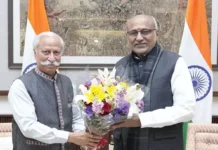[ Tayi Taggu ]
The “Clean India Mission,” or “Swachh Bharat Abhiyan,” aimed at enhancing India’s cleanliness and hygiene nationwide, was launched by the visionary Prime Minister Narendra Modi on 2nd October, 2014 on the occasion of the birth anniversary of Mahatma Gandhi. This initiative is the largest cleanliness drive undertaken so far by the Indian government and the respective governments of the state. “Ek Kadam Swachhata Ki Aur” has been the most popular slogan of the Swachh Bharat Mission for the past 10 years, etched in the minds of a billion plus citizens of India. However, there is still a long way to go in the matter of cleanliness in the country. Despite our 10-year mission of cleanliness, India still faces significant cleanliness challenges. Our towns and cities are littered with waste as we generate more and more of it by exploiting natural resources far beyond our actual needs to satisfy our greed and lust for prosperity and luxury.
The sheer volume of waste generated by exploiting natural resources beyond our needs poses a substantial problem. Our towns and cities are plagued by litter, polluted streams and toxic industrial waste. Don’t Indians deserve a better living standard? The issue lies in our actions and inactions. Most of our problems are the results of a blend between our actions and inactions because we do not care to clean but instead find it easier to litter. Our surroundings might be stinking, but we conveniently shift the responsibility of cleaning to the government.
This is a war that we cannot afford to lose if our future generations are to thrive as their forefathers once did in the lap of Mother Earth. The famous proverb “cleanliness is next to godliness” resonates deeply but we shall be far from gods unless we are clean in our hearts, bodies and surroundings.
Yet, as intelligent beings, we are also the planet’s biggest polluters. Our battle against plastic pollution is critical and requires a collective effort. The real pressing need now is how to deal with the plastic menace and other toxic wastes that are hunting mankind down like a pack of wolves chasing a helpless deer. Thus, the billion-dollar question here is: can we find an alternate solution to do away with plastic or other toxic wastes? Do we have an eye to see waste as an opportunity? Can we monetize all waste and create wealth? Why not, provided there is proper segregation of waste at the source. Here the magic word is ‘segregation at source’ and if we do, this is one sure way to make our earth healthy and safer for future generations. Compost is a good source of manure, currently selling like hotcakes at a rate of Rs. 25-30/- per kg. Our district administration was told that a farmer who used such manure always came back with a larger demand and considered it good and organic, suitable for vegetables, crops, and soil fertility. However, mixed-up waste is not only difficult to segregate but hazardous and economically not viable as well.
Compared to human beings, nature is efficient, holistic, and powerful yet creates no waste whatsoever. Nature has a built-in system that has the power to recycle and regenerate everything that seems to be a waste from our viewpoint. In our daily routine, we are confronted with mountains of waste in almost every town and city in India because we use more things than are required for survival. Most of our needs arise from a lust for a luxurious life, which is really not essential. Basically, our greed and feeling of insecurity have driven us to use more things than necessary, resulting in the generation of surplus waste for efficient disposal. If we do not control so much consumerism, we’re heading not only toward self-destruction but also the destruction of the only planet inhabited by us.
In theory, Arunachal Pradesh should be the cleanest state as it has the smallest population per sq. km of land in India, yet there are piles of garbage lying on roadside corners, water bottles littered on hilltops, and sinking to the bottom of our streams and rivers. Is it not a disgrace to us as Arunachalees? Arunachal’s scenic beauty and its mesmerizing hills are simply breathtaking. Yet dirt on the streets is a poor reflection of our cleanliness mission. More than the dirt on streets, the dirt in our minds requires cleaning first. We must re-jig our thought process that cleaning and cleanliness are the duties of the government but actually cleanliness should be everybody’s business, and when that happens, as Arunachal Pradesh has the promise to be the cleanest state in India. Some of the main issues plaguing waste management in Arunachal Pradesh are the lack of proper segregation at source and efficient collection and disposal systems, besides the uncooperative attitude of people considering that let the Sanitation Department run efficiently their systems alone.
Poor waste management in Arunachal certainly affects the aesthetic beauty of the environment and severely impacts the fragile ecology of our state. With the rise in population and the consequent increase in waste generation, the problem will only be compounded in the years to come. This calls for effective waste management with the implementation of best practices to be followed at all levels across the state. All communities should be empowered to charge for waste collection and disposal along with spot fines for littering; this will go a long way in the effective management of waste.
We had a three-day Urban Learning Network (ULN) workshop and field visits in Panjim, Goa this year from October 23-25. Peer-learning and cross-learning through field visits were amazing and had a positive impact on all the trainees. And it was an eye opener; while most towns and cities across India are implementing a 2-way (wet and dry) waste segregation system, the city of Panaji has implemented an innovative 16-way segregation at source by keeping all waste separately in different marked dustbins, e.g., batteries, cardboard, ceramic melamine, cloth, coconut shells, e-waste, expired/used medicine, glass, metal, non-recyclable items (slippers, wrappers of chips), paper, pet & hard plastic, soft plastic, sharp objects, sanitary biomedical waste, and tube lights, bulbs/CFL, etc. Segregation at source is easy, and if properly managed, it creates value. The 16-way waste segregation is economically viable, minimizes landfill use, and reduces environmental impact on our surroundings. Segregation separates the biodegradable component (wet) from the non-biodegradable component (dry). Compost the wet waste, derive high-quality manure, and improve soil fertility while doing so. Reuse and recycle whatever is possible before junking it.
Goa is a visionary in waste management compared to its peer states. The state-established Solid Waste Treatment Plant (with a total capacity of 100 tons per day), inaugurated at Saligao on 30th May 2016, is a state-of-the-art modern facility based on mechanical biological treatment (MBT) processes with proper segregation, recovery of recyclables, and bio-methanation processes.
Mr. Gaurav Pokle, Founder & CEO, YIMBY (Yes-In-My-Back-Yard) says he sees “waste as an opportunity to make money, and if people see an opportunity in waste, there will be no waste in our country.” When I asked him, whether he was generating good revenue out of the waste business and from where he got his ideas? He apprised us that during his tour of Spain, he saw how they dispose of waste while generating electricity from it and loved their idea. When he started the business, he suffered a loss of Rs. 75 lacs in the first year and Rs. 40 lacs in the second year. But YIMBY started a turnaround with profits of Rs. 1.2 crores in the 3rd year, Rs. 3 crores in the fourth year, Rs. 4 crores in the fifth year, and another 4 crores by September 2024 before the completion of their sixth year. But one must remember that turning waste into gold is not easy unless segregation is done properly at the source, and making money out of waste is not easy either.
As a waste generator, we must prioritize waste reduction at source. The well-established waste management principles strongly advocate waste minimization as the first step, as it drastically reduces the amount of resources and infrastructure needed in the whole waste management process. Door-to-door collection systems should be put into place to collect segregated waste and avoid any waste, especially mixed waste, going into common waste receptors. This is strongly encouraged, as it retains waste in its best form possible and thus helps in achieving optimum composting and recycling rates.
This year’s theme ‘Swachhata Hi Seva’ campaign ran from 17th September to 1st October, 2024 and saw greater public participation and infused the feeling of sanitation as everyone’s business, which culminated on 2nd Oct, 2024 last. The objective here is to make India cleaner and healthier through these initiatives on cleanliness and environmental sustainability under the theme ‘Swabhav Swachhata-Sanskaar Swachhata’. ‘The Swachhata Hi Sewa,’ pledges are “not to litter nor let others to litter and to avoid the use of single-use plastics in daily life.” To propagate the message of the ‘Swachhta Hi Sewa Mission’ in villages, towns, and cities of the country, the government has provided financial aid to build over 10 crores toilets in homes, schools, and hospitals across the country; provided potable water; made separate toilets for boys and girls; improved the quality of life for the people of India; and 36 states and union territories combined have become defecation-free. This mission has received tremendous support from citizens, who have turned out in large numbers to help propagate cleanliness. Cleanliness is a lifestyle choice that everyone should make and practice. It should be a ritual at home, school, college, workplace, industries, and public places. Every one of us can serve Mother India by keeping our country neat and clean. A clean India is a healthy India after all. Let’s clean our minds, body, home, and environment while using this as our new mantra!!! (The author is Deputy Commissioner of East Siang district of Arunachal Pradesh)



